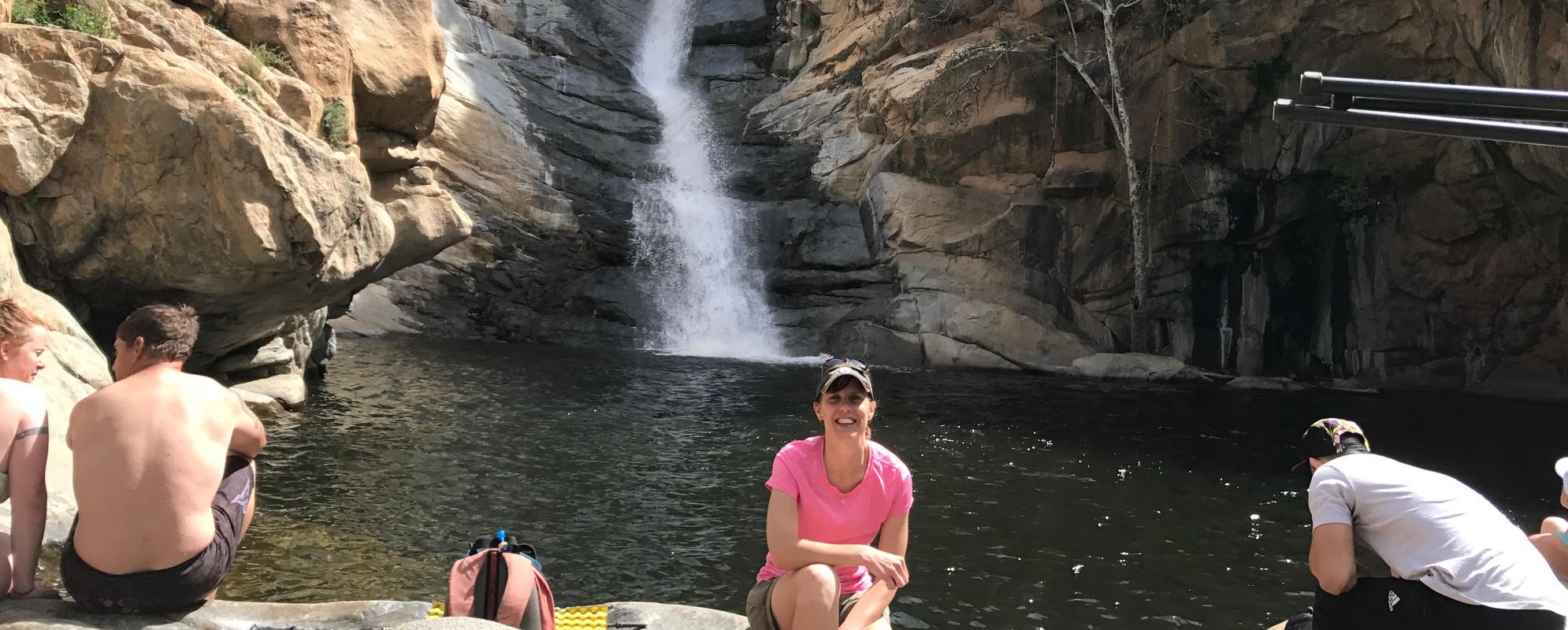As summer approaches, the days become longer, the weather warms up and many of us want to get outdoors and explore the trails to local watering holes and waterfalls. Two of the most popular hikes in the area are Cedar Creek Falls and the Three Sisters Falls. What many people don’t realize is that these trails can get extremely hot and have little shade. In addition, they are canyon hikes…meaning the hike starts with a descent and to finish the hike you must go uphill. On a weekend in July 2017, 8 people were rescued from the Three Sisters Falls trail due to heat related issues and recently a young woman died due to dehydration and being overheated. Even for the most fit, these hikes can be extremely challenging on a hot day.
Many of the trails in San Diego county get can extremely hot during the summer months, with proper planning and avoiding the hot days, you can experience many of the hikes the county and the surrounding area has to offer.
Do the following before heading out on a summer hike to beat the heat:
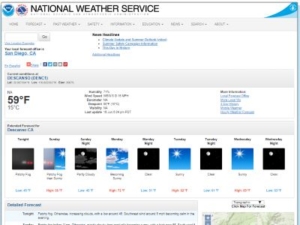 1. Check the Weather Report
1. Check the Weather Report
Weather in San Diego county can vary drastically from the coast, to the mountains, to the desert and therefore, it’s a good idea to check the weather report prior to heading out for your hike any time of the year. If you have a hike in mind and the weather report calls for a hot day…save that hike for another day and choose a destination that is cooler or consider a different activity.
2. Choose Hiking Locations with Shade or at Cooler Temperatures
San Diego and the surrounding area provides a variety of hiking options. On hot days, choose to hike in locations that provide shade or are along the coast or at higher elevations where are temperatures are often cooler. Hikes along streams, rivers and lakes are a bonus! Not only can you cool off in the water, you can carry less drinking water providing that you have a water filter or bring chemicals to treat the water. Be sure to check on the water levels for safe entry and to ensure that there is water to filter as many natural water sources tend to dry up in the summer months in Southern California.
3. Avoid Hiking During the Hottest Times of the Day
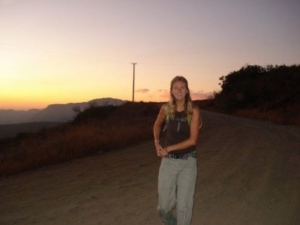
Go hiking early in the morning, late afternoon or in the evening when the sun is not at its hottest temperatures. Avoid hiking between 10:00 AM and 3:00 PM.
4. Stay Hydrated
Drink a liter or quart of water prior to starting your hike so that you are hydrated. Keep hydrated by drinking small amounts of water frequently. Remind others that you are hiking with to keep drinking. It’s easiest to drink water from a bladder reservoir while hiking. Bring along a 500ml bottle of water, so if you run out of water in your reservoir, you’ll have a backup and you’ll know that it’s time to look for a stream to filter water or head back to the trail head. In addition, it’s a good idea to keep extra drinking water in your car. When it’s hot, freeze a bottle of water, so it melts along the way and you can have a cold drink! On a regular day, the body needs roughly four liters or a gallon of fluids. In hot weather or with heavy exertion, your body will need more. For a hike to the Three Sisters Waterfalls, a minimum of a gallon of water per person is recommended. Warning signs: if you have a dry mouth, or “cotton mouth” or you are thirsty, if you don’t feel the need to urinate or your urine is dark/bright yellow (not due to the vitamins you just took), you might be at risk for dehydration and your body make not be working at its optimal level.
5. Replenish Electrolytes
As you sweat, your body loses electrolytes such as potassium, sodium, magnesium, phosphorus and calcium which may cause fatigue, muscle weakness, muscle cramps, confusion and nausea. You normally replenish your electrolytes with a balanced diet. When it’s hot and you are exerting yourself, your body loses electrolytes at a greater rate. Electrolytes can be replenished with sport drinks and powder mixes, electrolyte gels and chews. On hot day hikes, you can freeze coconut water drink boxes and then enjoy a slushy drink packed with electrolytes at the peak. This also makes a great ice pack to keep other foods chilled until lunch or an ice pack for a minor injury.
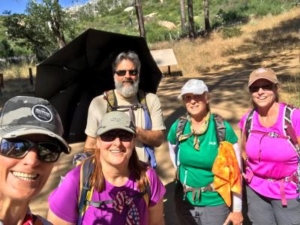
6. Create Your Own Shade – Use an Umbrella
Many of the hikes in San Diego tend to be void of shade when you need it the most. Create your own shade by carrying an umbrella. Several instructors with the San Diego Wilderness Basics Course carry the Liteflex Hiking Umbrella from Gossamer Gear for its durability, lightweight, extended canopy and UV protection fabric.
7. Wear Breathable Loose Fitting Clothing
Choose clothing that is lightweight, loose fitting and breathable to help regulate your body’s temperature. Avoid dark clothing as it tends to attract the sun’s rays and make you hotter. Go for a lighter color palette…plus dirt doesn’t show up as much on sand color and grey clothing. The Wilderness Basics Course has a saying “Cotton Kills”, however, in the hot summer months, cotton clothing is acceptable as the sweat trapped in the fabric can provide a cooling effect. Also, you can soak a cotton top in a stream or in a wide-mouthed Nalgene bottle with water to cool you off!
8. Wear a Hat, Sunglasses & Sunscreen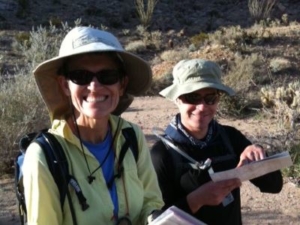
From baseball style hats, trucker hats, wide brim hats to gardening hats…pick one that you like and wear it! Hats with broader brims tend to be better in shielding your eyes, face, neck and ears from the sun. Even with a hat, it’s important to protect your eyes by wearing sunglasses and sunscreen to prevent your skin from burning. Remember to apply sunscreen to the back your ears…as it’s a spot that can easily burn and most people forget this area until it’s too late!
9. Know Your Limits
Before going on any outing, it’s always a good idea to assess the physical demands of the hike for you and your entire group. A hike that seems effortless on a cool day could easily deplete your energy on a hot day. If you or anyone in your group, is having a hard time with the hike, it’s better to turn around and do the hike another day, than to never hike again.
10. Know the Signs & Symptoms of Heat Cramps, Heat Exhaustion & Heat Stroke
Learn about the signs and symptoms of heat cramps, heat exhaustion, heat stroke and what first aid measures to take in this article by the American Red Cross. Recognizing the signs and symptoms early and knowing what to do, can make the difference between life and death.
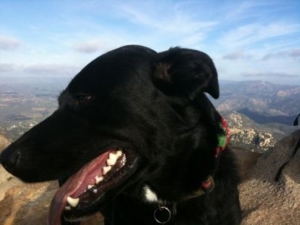 11. Leave your Dog at Home
11. Leave your Dog at Home
We all love to take our dogs with us when we go for a hike as what dog doesn’t love the opportunity to get outdoors? However, when the temperatures heat up, it’s best to leave your four-legged friend at home where it’s not hot. Dogs can easily get heat exhaustion as they don’t have the same mechanisms as we do to shed heat.
12. Carry the 10 Essentials
If an emergency does occur and you find yourself having to spend unexpected time in the outdoors or even the night, the 10 Essentials can make the difference. There are more than 10 essentials, but all experts agree on carrying the following: navigation (map and compass), sun protection (sunglasses, sunscreen, hat), insulation (clothing), illumination (headlamp, flashlight), first aid kit, fire starter (matches, lighter), repair kit (knife, tools), nutrition (extra food), hydration (extra water), and emergency shelter (rain gear, poncho, space blanket).
13. Have an Emergency Contact
It’s a great idea to have an emergency contact if you don’t return from your hike. Tell a reliable family member or friend your hiking plan. Provide them with the following information: who you are hiking with, the location of the trail head, the route you’ll be taking, when you plan to return and what to do if you don’t return. Remember to check in with your emergency contact when you get back to the car and have cell service, as you would hate for your emergency contact to send out a search & rescue team and you’re at a restaurant celebrating the day!
The Sierra Club mission is to explore, enjoy and protect the planet. The San Diego Chapter offers free hikes to the public with leaders trained in hiking and first aid. In addition, the award winning Wilderness Basics Course is offered in North County and San Diego each year from January to April. The course teaches the fundamentals of hiking, backpacking and camping safety in a 10-week course featuring lectures and 4 weekend practical outdoor outings.

